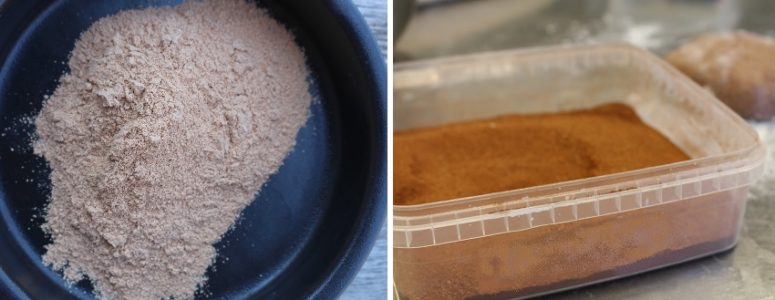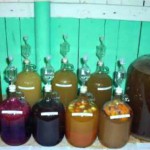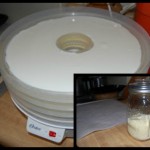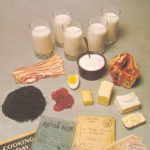Tree Bark Flour Basics Plus Birch and Pine Bread Recipes

Photos: nordicfoodlab.org-waldenlabs.com
Flour is a staple in just about every country in the world. It isn’t always the most stable though to store. You can store it longer if you dry can or freeze it prior to storage. However, no matter how much you are able to store eventually you will run out. Then what?
MIY flour of course.(make it yourself) Here in the USA the majority of commercial flours are made from grains and nuts. Not all of us will have easy access to either. But the majority of us will be able to locate a birch or a pine tree. Making flour from them is possible. They won’t taste the same, but do have nutritional value and a taste you can adjust too if you desire to try.
Get information on the usage, making of and recipes for both pine and birch flour breads from Aorta Foods featured below.
Birch
Papery white bark, long lean trunks with eye-like knots, the warming sweet smell of the sauna – birch trees (both Betula pubescens spp. and B. pendula spp.) are an iconic symbol of the Nordic region. They were among the earliest trees to re-colonize the land after the last ice age (Kullman, 2002) and grow abundantly all around the Northern Hemisphere with species spanning from Morocco to Greenland (pfaf.org). Aside from their distinctive outward appearance, many parts of birch are also used for food: their sap is traditionally drunk fresh, boiled down into syrup, and even brewed into beer (Buhner, 1998), and the small buds, harvested in the winter before they begin to shoot, are deeply resinous and aromatic. Yet birch’s great gastronomic potential does not end here. Below the outer bark, the inner bark has a beautiful reddish colour and a sweet woody aroma, and can bring a unique flavour to many dishes.
Flour from the inner birch bark, dried, ground, and sifted
This inner bark is also called phloem, the layer between the distinctive papery outer bark and inner hardwood. It is a living tissue, consisting notably of specialized filtering sieve-cells for transport of water and nutrients, starch-storing tissues, and other specialized cells for structural support of the tree (Sjölund, 1997). It is through the phloem that sap travels in early spring, carrying sucrose and other nutrients to nourish the tree as it begins to bud. Compared to the outer bark and inner hardwood, phloem has a lower concentration of anti-digestive compounds such as lignin and phenols (Chaney, 2003); in fact, it is relatively nutritious, with about 1000-1200 calories per kilogram, though it tends to have a bitter taste.
General tree anatomy and physiology.
A tree’s bark and wood consists of many distinct layers: the exterior bark comprised of dead, accumulated cells is called the rhytidome, while the entire outer bark layer is called the periderm; the inner bark is also called phloem and consists of vascular tubes to transport nutrients; the thin cambium below is made of living tissue that builds the phloem outward and provides a protective barrier against rot and disease; the sapwood is the newly formed wood containing living tissues and water; the heartwood is older, dryer and the core of the tree’s structural stability.
The outer birch bark has been widely used as a building material, and for food storage and preservation due to the antimicrobial properties of betulin, a compound (as the name would suggest) which the tree has in abundance (Haque et al 2014). Use of the phloem, however, has not been documented nearly as widely.
One group that historically uses the inner bark is the Sami people of northern Scandinavia, for whom the birch tree is nearly as central to their way of life as the reindeer. They typically harvest the bark from trees felled for timber, firewood, waterproofing, or handicrafts, peeling it off in large sheets from the smooth trunks while still fresh. Traditional practice warns against harvesting bark from the full circumference of a living tree lest its nutrient flow be cut off (Laila Spik, personal communication, 2015)—a process known as girdling, used in other contexts to manage forests and even to grow extremely large vegetables. Once harvested, the reddish brown, almost cork-like phloem is separated from the outer bark and left to dry either in the sun, by a fire or wood stove, or in a dehydrator. It is then ground into flour and used to make bread and crackers.
Birch flour does not contain the gluten proteins typically required to give bread structure and cohesion, and for this reason it is rarely used alone in baking. More often it is mixed with wheat or rye flour to make the dough more cohesive, and to smooth its bitter taste. Bread using birch bark flour, for example, has been made in Sweden and Finland for centuries (Zackrisson et al., 1999).
Here is a recipe for a simple birch bark bread. The crumb has a beautiful reddish hue and a unique aroma, almost reminiscent of raspberries.
Birch bark bread
600g whole grain flour
400g tipo 00 flour
75g birch flour
20g salt
925g water
200g sourdough starterCombine ingredients and soak overnight. The next morning add 200g sourdough. Over the next 4-5 hours turn the dough every 45-60 minutes by pulling up one corner and folding it over onto itself. Give the bowl a quarter turn and repeat until you have made it all the way around.
Shape loaves into tight rounds and let them rest for 20 minutes. Then fold them into tight packages and place in a rising basket. Allow to rise for 2-3 hours.
Place Dutch oven with lid into oven and preheat oven to 250°C. Once hot, drop the dough into the pot, score, and put the lid back on. Decrease temperature to 230°C and bake for 20 minutes. Remove the lid and bake for another 25 minutes until the crust turns a beautiful golden brown.
Pine
The bark from the rugged, ancient pines (Pinus sylvestris spp.) of northern Scandinavia is also a source of flour for breads and baking. The Sami traditionally harvest the bark from living trees in vertical strips that wrap no more than one-third around a tree’s circumference—a method known as ‘window pane-ing’ (Laila Spik, personal communication, 2015). Typically the strip is harvested using a steel or bone blade to make horizontal cuts at the top and bottom of the strip then using a scraper to peel the strip down vertically, leaving the cambium undamaged below (Zackrisson et al., 1999). Harvesting occurred during most of the snow-free months, although specifically in June, and was most often carried out by women (ibid.). Prior to the 19th century, the trees were most often stripped on the north/northwest/northeast side of the trunk, and first strippings were most likely to be facing north, with subsequent ones facing other directions (ibid.). Interestingly, evidence of stripping from the 19th century does not indicate a specific preference for direction.
In the days before modern communication, seeing fresh window panes on pine trees was a signal to travelling Sami that others were living nearby (Laila Spik, personal communication, 2015). Indeed these window-panes are still visible on some Lapland pines, some grown over for hundreds of years: the 700-800 year old pines around Laila’s home, near Stora Sjöfallet National Park, register evidence of the most active continuous use of pine bark of anywhere in Sweden during the period between 1450 and 1890 (Zackrisson et al., 1999). Pines are less desirable than birch for fire and construction, and are thus typically felled less often, so harvesting respectfully from the living tree is appropriate in this case. The pines from which bark was harvested were also in many considered cases sacred, and would not be used for firewood also for this reason (ibid.).
The eating of pine tree bark in the Nordic regions has commonly been regarded as a famine activity—yet the historical evidence suggests otherwise:
“There is no indication in our records that historically well-known famine years resulted in more bark being peeled in those years (see also Niklasson et al. 1994). This may strengthen the interpretation that inner bark was not a famine food for Sami, in contrast to what has been described among Nordic and Finnish farmers (Hansson 1996). The use of bark for food among Sami people was instead always described in the 1600’s and 1700’s as a normal staple food resource (Schefferus 1674; Leem 1767; Rheen 1897; Graan 1899; Lundius 1905; Drake 1918). It has also been pointed out that rich Sami families with many tamed reindeer and large milk production normally collected the largest quantities of Scots pine inner bark for food (Drake 1918), which is understandable as inner bark was often mixed into milk (Schefferus 1674).” (Zackrisson et al., 1999)
Thus, when it comes to Sami culture, use of pine bark may have been much more connected with wealth (in the form of more reindeer and their milk) than poverty and famine. Nonetheless, the use of bark in the 18th and 19th centuries was often described as primitive and as a sign of extreme poverty (ibid.). The 19th century saw official claims that eating bark and its products was dangerous and unhealthy; Swedish authorities generated intense propaganda against the use of bark for food; and from 1870 onwards Swedish legislation forbade the harvesting of bark from trees growing on crown land (ibid.).
There are many documents suggesting that pine flour be made from the phloem similarly to birch (MacWelch, 2014; Gottesfeld 1992; Zackrisson et al., 1999). However, Laila’s recipe for making pine bark flour is simply to harvest the shaggy outer bark (rhytidome) which can be flaked off relatively easily with a sharp knife. The grey surface is weathered and can be discarded in favour of the rusty-coloured, aromatic layers lying below, just above the smooth, white cambium. Similar to the method for birch, the harvested pine bark flakes should be dried and ground into a flour using a stone grinder, a mortar and pestle, an electric blender or mill, or a combination of these methods. The pine flour is then mixed with wheat, spelt or rye flour and typically baked into thin knäckebröd, or Swedish crisp bread. It is also well documented that the phloem and cambium can be made into flour by stripping away the rhytidome and periderm and peeling the cambium off in sheets, dehydrating it, and then grinding into powder (Zackrisson et al., 1999). This kind of harvesting should only be done on non-living branches or trees because of the damage it would do to the living tree. Small pieces of the cambium can also be enjoyed as a fresh mid-harvest treat, with a sweetness and texture reminiscent of fresh coconut meat.
Nutritionally, the periderm and rhytidome are not as generous as the phloem or cambium as they do not contain starches or carbohydrates digestible to humans (Chaney, 2005). However, they do contain condensed tannins called procyanidins that are being researched for potential health benefits (Li et al., 2015). Aromatic hydrocarbons such as terpenes and phenols which give pine its distinctive warm, woody scent also deliver antimicrobial properties, perhaps useful for blending with other flours to preserve their shelf life. The phloem of the pine is rich in ascorbic acid (Vitamin C), which during the 1800s helped the Sami of the interior of Norway and Sweden avoid the scurvy that was at the time devastating the coastal populations of non-Sami farmers (Zackrisson et al., 1999).
I [Anna] learned how to make this bread from the outer bark from Laila Spik when I was learning from her this summer; the aroma that fills the kitchen while these are baking is irresistible and resinous, just like a walk in the pine forest.
Laila is pleased to share her recipe with pine bark flatbread with anyone who is interested. You can get in touch with her at laila.spik@gmail.com (or check out her website).I’ve recently been working on another recipe with the pine bark flour, which we served on Monday at a party to celebrate the 1-year anniversary of our move to KU and the past, present and future of NFL.
PINE BARK COOKIES
75g sugar
113g butter
1 egg white
60g pine bark flour
90g wheat flour
2g baking powder
2g salt1. Oven 180˚C, 10% humidity.
2. Cream together the butter and sugar; add lightly beaten egg white.
3. Sift together dry ingredients and slowly add to creamed mixture. Stir till combined.
4. The mixture should be quite fatty. Wrap, and place in refrigerator for one hour.
5. Roll between sheets of parchment very thinly (at this point it may be helpful to put the rolled out sheet in the freezer for 5 minutes to firm it up a little bit), and then cut out cookie shapes (I used 30mm circle cutter).
6. Bake on silicone for 5 minutes—less if they are very small, and more if they are larger.
7. Cool and enjoy sandwiching:
CELERIAC WHITE CHOCOLATE BUTTERCREAMapprox. 300g celeriac (½ large), peeled and cut into 5cm chunks
milk for poaching
90g white chocolate pieces
50mL heavy cream
2 sheets gelatin1. Poach the celeriac till very soft in two changes of milk.
2. Let cool and strain away milk (save for delicious rooty toot tootin’ lattes!!)
3. Purée with blender, then pass through tamis to remove fibres.
4. Heat the cream and chocolate over a basin, whisk to combine.
5. Soften gelatin in some water and melt over basin with a dash of cream. Whisk gelatin into chocolate mixture.
6. Pour over celeriac puree and blend thoroughly. Spread into container and let cool for at least 4 hours.
7. Purée celeriac white chocolate again for smoothness; spread on half of your pine cookies and ever so gently top with another pine cookie (they are delicate flowers).
8. Put in the refrigerator to set again, half an hour. Serve immediately and enjoy or they may become soggy.Contributions
Avery wrote the first version of the Birch section, and developed the bread recipe. Anna wrote the Pine section, developed the pine biscuit recipe, and updated information and added citations throughout.Works Cited
Buhner, Stephen Harrod. Sacred and Herbal Healing Beers: The Secrets of Ancient Fermentation. Siris Books: Boulder. 1998.
Chaney, William R. “Why Do Animals Eat The Bark and Wood of Trees and Shrubs.” Forest and Natural Resources (2003): n. pag. Purdue University, Aug. 2003. Web. 30 June 2014.
“Digestibility of Plants.” Plant Structure & Function. University of Waikato, n.d. Web. 30 June 2014.
Gottesfeld, Leslie M. Johnson. The importance of bark products in the aboriginal economies of Northwestern British Columbia, Canada. Economic Botany, 46:2. 148-157. Web. 29 October 2015.
Haque, S., Nawrot, D. A., Alakurtti, S., Ghemtio, L., Yli-Kauhaluoma, J., Tammela, P. “Screening and Characterisation of Antimicrobial Properties of Semisynthetic Betulin Derivatives.” Panepinto J, ed. PLoS ONE. 2014;9(7):e102696. doi:10.1371/journal.pone.0102696.
Huebner, Matt. “Study Shows Metabolic Benefits of Birch Bark.” Next Level Nutrition. N.p., 14 May 2011. Web. 30 June 2014.
Kullman, L. (2002). “Boreal tree taxa in the central Scandes during the Late-Glacial: implications for Late-Quaternary forest history.” Journal of Biogeography, 29: 1117–1124. doi: 10.1046/j.1365-2699.2002.00743.x
Li, S., Xu, M., Niu, Q., Xu, S., Ding, Y., Yan, Y., Guo, S. & Li, F. Efficacy of Procyanidins against In Vivo Cellular Oxidative Damage: A Systematic Review and Meta-Analysis. PLoS ONE. 1 October 2015. Web. 29 October 2015.
Lindsey, Rebecca. “The Migrating Boreal Forest : Feature Articles.” The Migrating Boreal Forest : Feature Articles. NASA Earth Observatory, 20 Aug. 2002. Web. 30 June 2014.
MacWelch, Tim. “Survival Foods: Can You Really Eat Tree Bark? | Outdoor Life Survival.” Survival Foods: Can You Really Eat Tree Bark? | Outdoor Life Survival. Outdoor Life, 9 Nov. 2011. Web. 30 June 2014.
Sjölund, Richard D. The Phloem Sieve Element: A River Runs through It. The Plant Cell, 9. 1137-1146. July 1997. Web. 29 October 2015.
Zackrisson, O., Ostlund, L., Korhonen, O., and Bergman. The ancient use of Pinus sylvestris L. (Scots pine) inner bark by Sami people in northern Sweden, related to cultural and ecological factors. Vegetation History and Archaeobotany, 9:2. 99-109. July 2000.Nordic Food Lab
Non-Profit Open-Source Reasearch Organization
Nordic Food Lab is a non-profit, open-source organisation that investigates food diversity and deliciousness. Established in 2008, we combine scientific and humanistic approaches with culinary techniques from around the world to explore the edible potential of the Nordic region.
Source: Originally posted at a currently inactive link from aortafood
 This is an aggregated site. Please be aware some of the sites we link you to could have pop ups. We have no control over them. However, we will never link you to a site that requires you to make any purchase to view the blog.
This is an aggregated site. Please be aware some of the sites we link you to could have pop ups. We have no control over them. However, we will never link you to a site that requires you to make any purchase to view the blog.
Please read our disclaimer. We provide you with information from various sites all over the world. The author’s expressed opinion isn’t necessarily that of The Prepared Page or its staff. Our intent is to bring you the information. Use your and your own best judgment when using any information contained within the blogs.
While you’re here check out some of those other posts you may find them interesting!!!
Some posts may include affiliate links.







